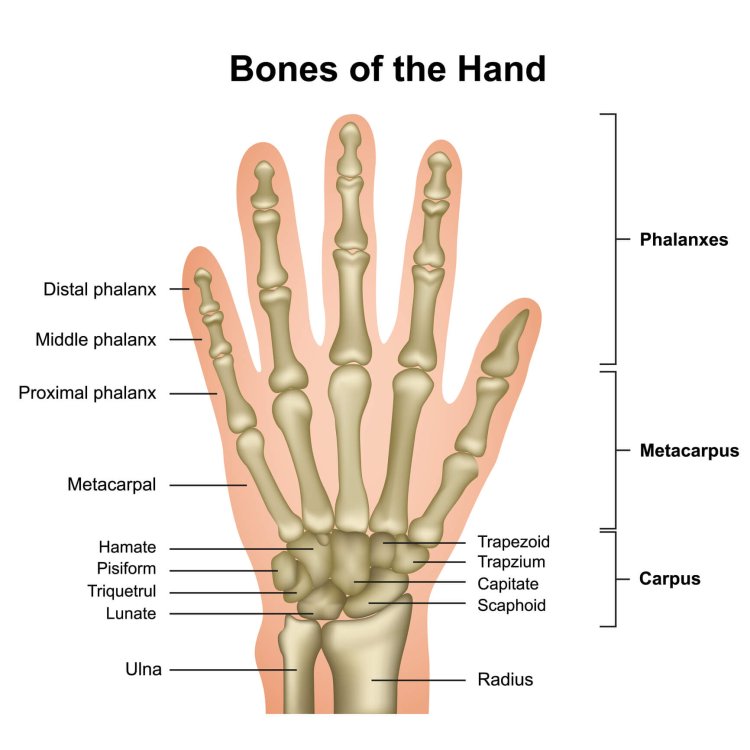Bones of the Hand and Wrist: An In-Depth Exploration
Bones of the Hand and Wrist: An In-Depth Exploration
Share this Post to earn Money ( Upto ₹100 per 1000 Views )

I. Introduction
A. Overview of the Hand and Wrist Anatomy
The hand and wrist consist of a complex arrangement of bones that enable a wide range of movements and functions. Understanding the anatomy of these structures is crucial for appreciating how they work together to facilitate daily activities. Buy real human hand bones here
B. Importance of Understanding the Bones in These Areas
Knowledge of the bones in the hand and wrist is essential for healthcare professionals, athletes, and anyone interested in maintaining hand health. This understanding aids in diagnosing injuries, treating conditions, and preventing further complications.
C. Purpose of the Blog Post
This blog post aims to provide a comprehensive overview of the bones of the hand and wrist, their functions, and their significance in maintaining hand health and mobility.
II. Anatomy of the Hand
A. Description of the Carpal Bones
1. List and Function of Each Carpal Bone
The eight carpal bones are categorized into two rows:
- Proximal Row:
- Scaphoid: Supports wrist movement; most commonly fractured.
- Lunate: Contributes to wrist stability and movement.
- Triquetrum: Provides structural support and stability.
- Pisiform: A sesamoid bone that acts as a pulley for the flexor carpi ulnaris muscle.
- Distal Row:
- Trapezium: Articulates with the thumb, allowing for opposition.
- Trapezoid: Stabilizes the second metacarpal.
- Capitate: The largest carpal bone; central to wrist motion.
- Hamate: Contains the hook of hamate, which serves as an attachment point for ligaments.
2. Arrangement and Classification (Proximal and Distal Rows)
The carpal bones are arranged in two rows, with the proximal row articulating with the radius and ulna, while the distal row connects to the metacarpal bones. This arrangement allows for a wide range of wrist movements, including flexion, extension, and rotation.
B. Metacarpal Bones
1. Structure and Significance
The five metacarpal bones form the framework of the palm. Each metacarpal consists of a base, shaft, and head, allowing for articulation with the carpal bones and phalanges.
2. Role in Hand Function
The metacarpals provide support and structure for the hand, enabling grasping and manipulation of objects. Their flexibility and alignment are crucial for effective hand function.
C. Phalanges
1. Types of Phalanges (Proximal, Middle, Distal)
Each finger contains three phalanges: proximal, middle, and distal. The thumb has only two (proximal and distal).
2. Importance in Finger Movement and Dexterity
Phalanges allow for intricate movements and dexterity in the fingers, which are essential for tasks such as writing, typing, and playing musical instruments. The joints between the phalanges enable bending and extending, contributing to the hand's overall functionality.
III. Anatomy of the Wrist
A. Overview of Wrist Structure
The wrist is a complex joint formed by the carpal bones and the distal ends of the radius and ulna. This structure allows for a wide range of motion while maintaining stability.
B. Articulation of the Wrist Bones
1. Interaction Between Carpal Bones and Forearm Bones (Radius and Ulna)
The wrist joint is primarily formed by the radius, which articulates with the scaphoid and lunate bones, while the ulna does not directly contact the carpal bones but is stabilized by the triangular fibrocartilage complex (TFCC).
2. Importance of Wrist Stability and Mobility
The intricate arrangement of the carpal bones, along with the ligaments and tendons surrounding the wrist, provides both stability and mobility. This balance is essential for performing everyday tasks and preventing injuries.
IV. Common Injuries and Conditions
A. Overview of Common Injuries (Fractures, Sprains)
Injuries to the hand and wrist are common, with fractures (especially of the scaphoid) and sprains being prevalent. These injuries can result from falls, sports activities, or repetitive strain.
B. Conditions Affecting the Bones of the Hand and Wrist (Arthritis, Carpal Tunnel Syndrome)
Conditions such as osteoarthritis and rheumatoid arthritis can affect the joints in the hand and wrist, leading to pain and reduced mobility. Carpal tunnel syndrome, caused by compression of the median nerve, can also result in pain and numbness.
C. Importance of Early Diagnosis and Treatment
Prompt diagnosis and treatment of injuries and conditions are vital for preventing long-term complications. Early intervention can help restore function and minimize pain.
V. Conclusion
A. Recap of the Significance of the Bones of the Hand and Wrist
The bones of the hand and wrist play a critical role in our ability to perform daily activities, from simple tasks to complex movements. Understanding their anatomy and function is essential for maintaining hand health.
B. Encouragement for Further Study and Awareness of Hand and Wrist Health
Continued education about hand and wrist anatomy, as well as awareness of potential injuries and conditions, can empower individuals to take proactive steps in caring for their hands.
C. Final Thoughts on the Impact of These Bones on Daily Activities and Overall Quality of Life
The intricate structure of the hand and wrist significantly impacts our quality of life. By appreciating their complexity and functionality, we can better understand the importance of maintaining hand health for overall well-being.














